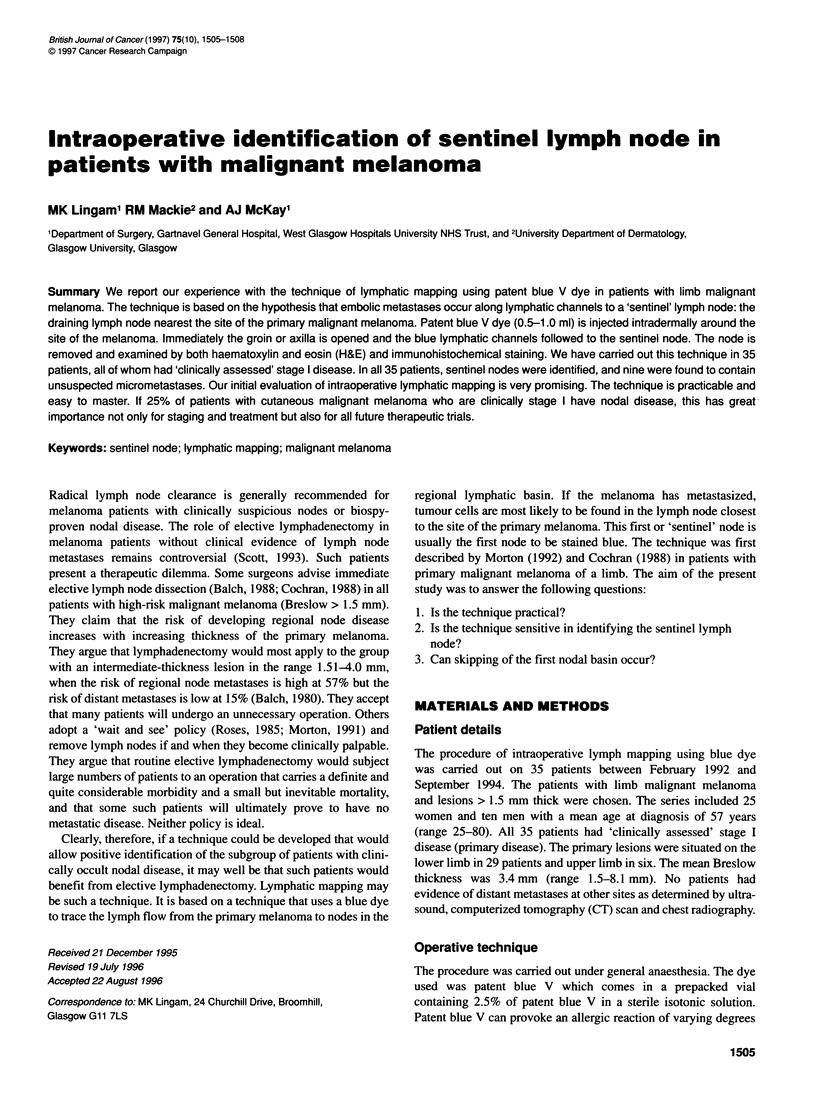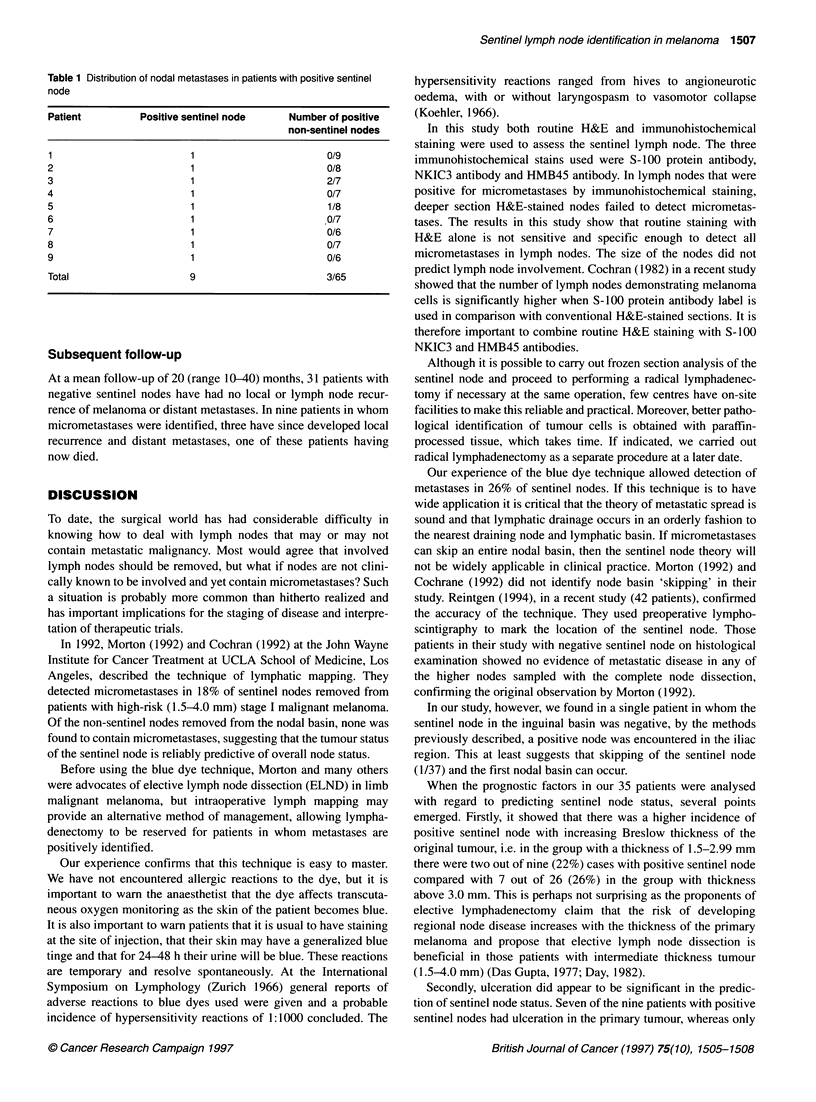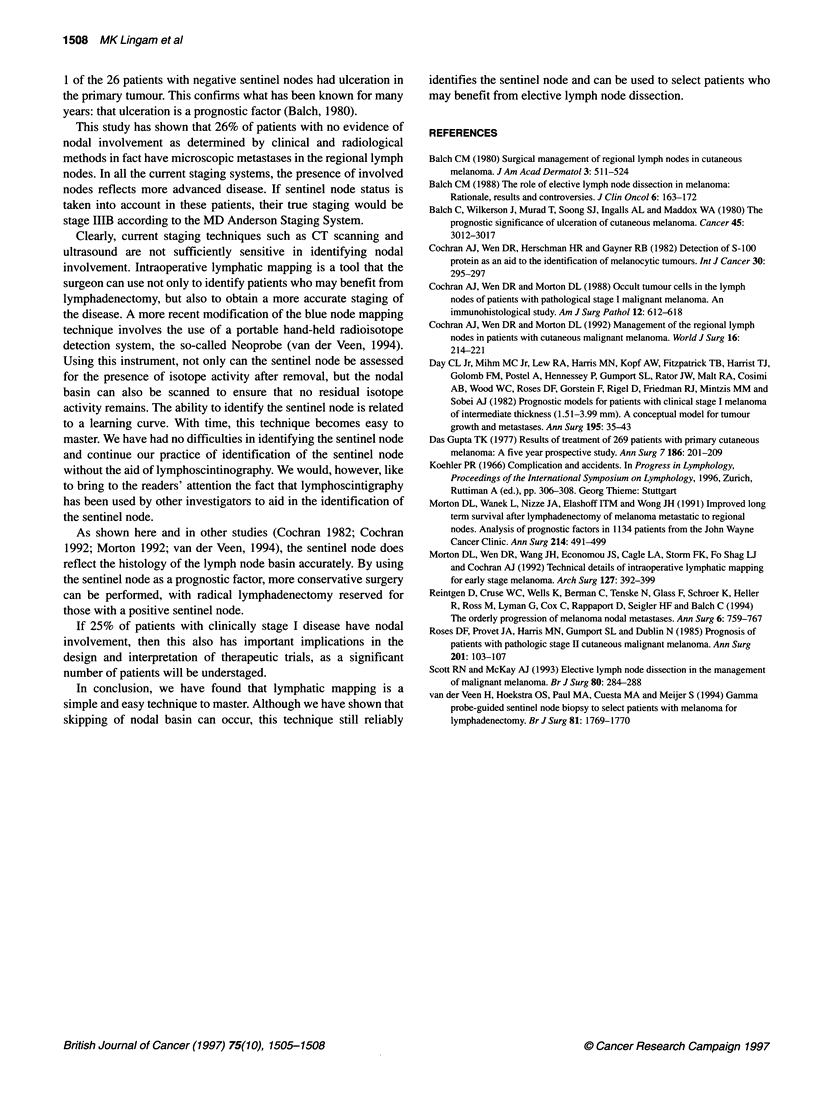Abstract
We report our experience with the technique of lymphatic mapping using patent blue V dye in patients with limb malignant melanoma. The technique is based on the hypothesis that embolic metastases occur along lymphatic channels to a 'sentinel' lymph node: the draining lymph node nearest the site of the primary malignant melanoma. Patent blue V dye (0.5-1.0 ml) is injected intradermally around the site of the melanoma. Immediately the groin or axilla is opened and the blue lymphatic channels followed to the sentinel node. The node is removed and examined by both haematoxylin and eosin (H&E) and immunohistochemical staining. We have carried out this technique in 35 patients, all of whom had 'clinically assessed' stage I disease. In all 35 patients, sentinel nodes were identified, and nine were found to contain unsuspected micrometastases. Our initial evaluation of intraoperative lymphatic mapping is very promising. The technique is practicable and easy to master. If 25% of patients with cutaneous malignant melanoma who are clinically stage I have nodal disease, this has great importance not only for staging and treatment but also for all future therapeutic trials.
Full text
PDF



Images in this article
Selected References
These references are in PubMed. This may not be the complete list of references from this article.
- Balch C. M. Surgical management of regional lymph nodes in cutaneous melanoma. J Am Acad Dermatol. 1980 Nov;3(5):511–524. doi: 10.1016/s0190-9622(80)80118-6. [DOI] [PubMed] [Google Scholar]
- Balch C. M. The role of elective lymph node dissection in melanoma: rationale, results, and controversies. J Clin Oncol. 1988 Jan;6(1):163–172. doi: 10.1200/JCO.1988.6.1.163. [DOI] [PubMed] [Google Scholar]
- Balch C. M., Wilkerson J. A., Murad T. M., Soong S. J., Ingalls A. L., Maddox W. A. The prognostic significance of ulceration of cutaneous melanoma. Cancer. 1980 Jun 15;45(12):3012–3017. doi: 10.1002/1097-0142(19800615)45:12<3012::aid-cncr2820451223>3.0.co;2-o. [DOI] [PubMed] [Google Scholar]
- Cochran A. J., Wen D. R., Herschman H. R., Gaynor R. B. Detection of S-100 protein as an aid to the identification of melanocytic tumors. Int J Cancer. 1982 Sep 15;30(3):295–297. doi: 10.1002/ijc.2910300307. [DOI] [PubMed] [Google Scholar]
- Cochran A. J., Wen D. R., Morton D. L. Management of the regional lymph nodes in patients with cutaneous malignant melanoma. World J Surg. 1992 Mar-Apr;16(2):214–221. doi: 10.1007/BF02071523. [DOI] [PubMed] [Google Scholar]
- Cochran A. J., Wen D. R., Morton D. L. Occult tumor cells in the lymph nodes of patients with pathological stage I malignant melanoma. An immunohistological study. Am J Surg Pathol. 1988 Aug;12(8):612–618. doi: 10.1097/00000478-198808000-00002. [DOI] [PubMed] [Google Scholar]
- Day C. L., Jr, Mihm M. C., Jr, Lew R. A., Harris M. N., Kopf A. W., Fitzpatrick T. B., Harrist T. J., Golomb F. M., Postel A., Hennessey P. Prognostic factors for patients with clinical stage I melanoma of intermediate thickness (1.51 - 3.39 mm). A conceptual model for tumor growth and metastasis. Ann Surg. 1982 Jan;195(1):35–43. doi: 10.1097/00000658-198201001-00006. [DOI] [PMC free article] [PubMed] [Google Scholar]
- Gupta T. K. Results of treatment of 269 patients with primary cutaneous melanoma: a five-year prospective study. Ann Surg. 1977 Aug;186(2):201–209. doi: 10.1097/00000658-197708000-00013. [DOI] [PMC free article] [PubMed] [Google Scholar]
- Morton D. L., Wanek L., Nizze J. A., Elashoff R. M., Wong J. H. Improved long-term survival after lymphadenectomy of melanoma metastatic to regional nodes. Analysis of prognostic factors in 1134 patients from the John Wayne Cancer Clinic. Ann Surg. 1991 Oct;214(4):491–501. doi: 10.1097/00000658-199110000-00013. [DOI] [PMC free article] [PubMed] [Google Scholar]
- Morton D. L., Wen D. R., Wong J. H., Economou J. S., Cagle L. A., Storm F. K., Foshag L. J., Cochran A. J. Technical details of intraoperative lymphatic mapping for early stage melanoma. Arch Surg. 1992 Apr;127(4):392–399. doi: 10.1001/archsurg.1992.01420040034005. [DOI] [PubMed] [Google Scholar]
- Reintgen D., Cruse C. W., Wells K., Berman C., Fenske N., Glass F., Schroer K., Heller R., Ross M., Lyman G. The orderly progression of melanoma nodal metastases. Ann Surg. 1994 Dec;220(6):759–767. doi: 10.1097/00000658-199412000-00009. [DOI] [PMC free article] [PubMed] [Google Scholar]
- Roses D. F., Provet J. A., Harris M. N., Gumport S. L., Dubin N. Prognosis of patients with pathologic stage II cutaneous malignant melanoma. Ann Surg. 1985 Jan;201(1):103–107. [PMC free article] [PubMed] [Google Scholar]
- Scott R. N., McKay A. J. Elective lymph node dissection in the management of malignant melanoma. Br J Surg. 1993 Mar;80(3):284–288. doi: 10.1002/bjs.1800800307. [DOI] [PubMed] [Google Scholar]
- van der Veen H., Hoekstra O. S., Paul M. A., Cuesta M. A., Meijer S. Gamma probe-guided sentinel node biopsy to select patients with melanoma for lymphadenectomy. Br J Surg. 1994 Dec;81(12):1769–1770. doi: 10.1002/bjs.1800811220. [DOI] [PubMed] [Google Scholar]




